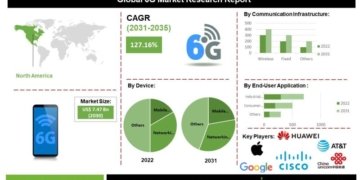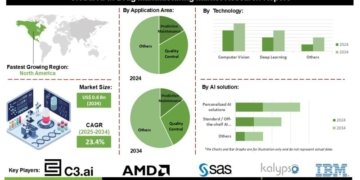We’ve updated all our reports with current data on tariff changes, trade developments, and supply chain shifts affecting key industries.
What Is the Heterogeneous Integration Market Size and Projected Growth Rate?
In recent times, the market size for heterogeneous integration has seen a significant upsurge. The market is projected to climb from a value of $0.79 billion in 2024 to a staggering $1.05 billion in 2025, showcasing a Compound Annual Growth Rate (CAGR) of 31.8%. A multitude of factors can be credited for this historic growth phase, including a surge in the need for top-notch computing capabilities, swift advancements in Internet of Things (IoT) and Artificial Intelligence (AI) technologies, wider acceptance of sophisticated packaging methods, increased consumer preference for small and multi-use devices, expansion in 5G network infrastructure, and a notable rise in energy-saving solutions in the electronics sector.In the coming years, the market size for heterogeneous integration is projected to experience rapid growth, expanding to a value of $3.12 billion in 2029, with a CAGR of 31.4%. Multiple factors such as the surging demand for superior computing performance, increased use of IoT gadgets, widespread establishment of 5G networks, heightened need for energy-saving electronics, and broadening use in self-driving vehicles contribute to the anticipated growth for the forecasted period. The period is also likely to witness trends like progress in 3D packaging, cutting-edge developments in system-in-package (SiP) designs, advanced interconnect technologies, amalgamation of electronics and photonics, enhanced solutions for thermal management, device miniaturization in the context of IoT and wearable technology, as well as advancements in material technology.
Purchase the full report for exclusive industry analysis:
https://www.thebusinessresearchcompany.com/purchaseoptions.aspx?id=21476
What Are the Major Segments in the Heterogeneous Integration Market?
The heterogeneous integration market covered in this report is segmented –
1) By Component: Advanced Manufacturing And Multi-Chip Integration, Integrated Photonics, Integrated Power Electronics, Microelectromechanical Systems (MEMS) And Sensor Integration, 5G, Radio Frequency (RF) And Analog Mixed Signal
2) By Design: Co-Design, Modeling And Simulation
3) By End-User: Semiconductor And Electronics, Information Technology (IT) And Telecommunications, Automotive And Transportation, Healthcare And Life Sciences, Manufacturing And Industrial, Aerospace And Defense, Other End Users
Subsegments:
1) By Advanced Manufacturing And Multi-Chip Integration: 2.5D And 3D Packaging, Fan-Out Wafer-Level Packaging (FOWLP), System-In-Package (SiP)
2) By Integrated Photonics: Silicon Photonics, Optical Interconnects, Photonic Integrated Circuits (PICs)
3) By Integrated Power Electronics: Wide Bandgap Semiconductors (SiC, GaN), Power Modules, Smart Power ICs
4) By Microelectromechanical Systems (MEMS) And Sensor Integration: Inertial Sensors, Pressure And Environmental Sensors, BioMEMS And Microfluidic Devices
5) By 5G: mmWave Antennas, Beamforming Technologies, 5G Baseband And RF Integration
6) By Radio Frequency (RF) And Analog Mixed Signal: RF Front-End Modules, Mixed-Signal ASICs, High-Frequency Amplifiers And Filters
Get your free sample here:
https://www.thebusinessresearchcompany.com/sample.aspx?id=21476&type=smp
What Are The Driving Heterogeneous Integration Market Evolution?
The escalating adoption of IoT devices is predicted to fuel the expansion of the heterogeneous integration market. These devices consist of interconnected objects that possess sensors and software and communicate via the internet. This allows data exchange and automation across multiple applications such as household, industrial, and health sectors. The driving force behind the surge in IoT devices’ adoption is the mounting need for connectivity, automation, and data-oriented decision-making in various sectors. Heterogeneous integration amplifies IoT devices by facilitating the effortless integration of assorted components like sensors, processors, and communication modules into compact, energy-saving systems. This ensures top-notch performance and multi-functionality to cater the needs of connected applications. For instance, Ericsson, a Swedish network and telecommunications firm, predicted in November 2022 that the count of IoT-connected devices would surge to 34.7 billion by 2028, a significant increase from 13.2 billion in 2022. Thus, the mounting adoption of IoT devices is propelling the expansion of the heterogeneous integration market. Surge In Demand For Smartphones Propelling The Market Growth Via Improved Performance And Efficiency
Which Firms Dominate The Heterogeneous Integration Market Segments?
Major companies operating in the heterogeneous integration market are Samsung Electronics Co. Ltd., Taiwan Semiconductor Manufacturing Company Limited (TSMC), Intel Corporation, International Business Machines Corporation, Qualcomm Incorporated, Broadcom Inc., Micron Technology Inc., Hewlett Packard Enterprise Company, NVIDIA Corporation, Applied Materials Inc., Advanced Micro Devices Inc., ASE Technology Holding Co. Ltd., STMicroelectronics NV, Analog Devices Inc., GlobalFoundries Inc., EV Group, SkyWater Technology Inc., Micross Components Inc., Etron Technology, Silicon Austria Labs GmbH
Get the full report for exclusive industry analysis:
https://www.thebusinessresearchcompany.com/report/heterogeneous-integration-global-market-report
Which Is The Largest Region In The Heterogeneous Integration Market?
North America was the largest region in the heterogeneous integration market in 2024. Asia-Pacific is expected to be the fastest-growing region in the forecast period. The regions covered in the heterogeneous integration market report are Asia-Pacific, Western Europe, Eastern Europe, North America, South America, Middle East, Africa.
Frequently Asked Questions:
1. What Is the Market Size and Growth Rate of the Heterogeneous Integration Market?
2. What is the CAGR expected in the Heterogeneous Integration Market?
3. What Are the Key Innovations Transforming the Heterogeneous Integration Industry?
4. Which Region Is Leading the Heterogeneous Integration Market?
Why This Report Matters:
Competitive overview: This report analyzes the competitive landscape of the 3D imaging software market, evaluating key players on market share, revenue, and growth factors.
Informed Decisions: Understand key strategies related to products, segmentation, and industry trends.
Efficient Research: Quickly identify market growth, leading players, and major segments.
Connect with us on:
LinkedIn: https://in.linkedin.com/company/the-business-research-company,
Twitter: https://twitter.com/tbrc_info,
YouTube: https://www.youtube.com/channel/UC24_fI0rV8cR5DxlCpgmyFQ.
Contact Us
Europe: +44 207 1930 708,
Asia: +91 88972 63534,
Americas: +1 315 623 0293 or
Email: mailto:info@tbrc.info
Learn More About The Business Research Company
With over 15,000+ reports from 27 industries covering 60+ geographies, The Business Research Company has built a reputation for offering comprehensive, data-rich research and insights. Our flagship product, the Global Market Model delivers comprehensive and updated forecasts to support informed decision-making.
This release was published on openPR.


















